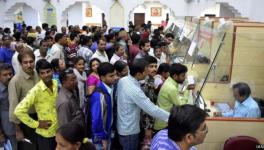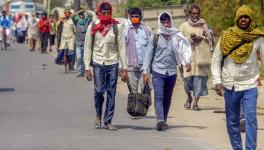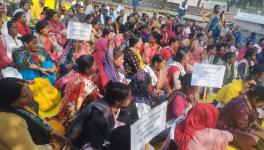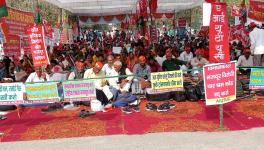April 2020: Indian Healthcare Takes Its Biggest Test Yet
Image use for Representational only. image Courtesy: The Financial Express
There are several reports on what the likely scenarios of Coronavirus attack in India are. Some predict an unprecedented catastrophe where it “will just rip through the population” and explain through advanced modelling how it can directly affect 30 million people or more. At the other end are the laudatory references to the government being successful in executing a total lockdown, and containing the virus to barely a few thousand cases.
This second set of pundits believe that the virus cannot survive in the high-temperature Indian summer that is setting in and among India’s younger demography and ‘high immunity’. Figures of SARS and Ebola or Nipha virus attacks, globally versus India, are being quoted to show how India is comparatively safer. Current figure of less than 4,000 cases of Corona positive seems to point towards that.
We all know India is a country of more than a billion people; it has extreme poverty in many areas; and many of its cities, such as Mumbai and Kolkata, are extraordinarily dense. Since people who live in India often travel between different states for work, the lockdown also left millions of migrant workers stranded; many of whom returned home on foot crossing hundreds of miles. Hence, all know that a major outbreak in a country with huge public health deficiencies is likely to have devastating, far-reaching consequences.
India's Predicament Now:
We need to first note that the virus struck China first (followed immediately by Japan and South Korea, and all these nations seem to have got a grip over the situation now), after a month it struck Italy and several European nations (where situation has worsened a lot, but of late the flattening of the curve has started), thereafter Iran, US and UK and others (where situation is now grave with a rising curve), then Middle East and South Asia (where the worst situation possible is yet to come in India, Pakistan, UAE & Saudi Arabia).
The period of caution had started since early March (and we are at least a week late to bring in lockdown) and that of concern for India is now over the next two to four weeks. First 1,000 cases happened in 8 weeks, second one in 4 days, the third one in 3 days, and the fourth 1,000 cases are now coming to light, over the last two days.
Like in these other countries, it probably happened in India because of airline traffic—but not because of people coming from China, all of whom were quarantined very early, but likely because of Italians who had carried the virus, who were tourists here. A number of the early cases actually involved Italians. So it arrived after it had fully seeded in Italy, and the testing was pretty low at the beginning.
What we expect is that this is probably because of testing not being adequate, similar to what happened in the early stage of the epidemic in the United States, as well, where it suddenly catches fire in some population, like in Seattle and then it really takes off. In India, it is not clear where it will catch up this way if at all, though the Tablighi Jamaat congregation has emerged as one major source. There is no evidence that the temperature and the humidity are slowing down the virus.
Health Infrastructure as a Challenge:
India has a lot of compounding problems, which are that the health-system capacity is generally weak across the country. The number of hospital beds [one bed for every 2,000 people] is remarkably low. It’s probably a fifth of what the UK has, for instance. And it has also got a population that has tuberculosis and respiratory issues and pneumonia and high rates of smoking and air pollution. So, the trajectory of the disease in this population is going to be unclear. It is to be noted here that already 53 doctors have tested positive even at this early stage of the spread of the disease in India.
Also about a third of the country’s adults are hypertensive, and about one-tenth of them are diabetic. And, so, all of this is likely to compound the problem. Thankfully the Indian Council for Medical Research (ICMR) has ordered for large scale testing of symptomatic patients which till now has been only 30 tests for every million people.
Surely some communities have got the disease and transmission has started. We have already seen cases in the slums of Mumbai, which is among the biggest slums in the world, with millions of people living next to each other. Then the Tablighi congregation of some 4,000 people in the second half of March led to cases spreading to Delhi, Tamil Nadu, Telangana etc.
The mass exodus of migrant labourers from Delhi-NCR mainly to Uttar Pradesh-Bihar, the huge congregation of devotees in Tirupati and Ayodhya recently and the mass celebrations at the end of 22 March Janata Curfew came next. It will be seen over the next two weeks if they were potential carriers of the disease. India’s population above the age of sixty-five is much smaller than that of Italy and certainly of China as well. That could have a protective effect—but it is not very certain yet what course the virus will take.
Lockdown Revisited:
The government’s shutdown order, at one level, seems sensible, though delayed. At another level, it is akin to a lot of what this government does; like demonetisation: implemented hurriedly without notice (two days in Australia and New Zealand, three days in Singapore) and without a ton of thought about how it was going to be put into effect. The human cost of this lockdown is already quite horrific. We have not seen the end of this lockdown story. Flitch says 2% of GDP growth will go down in the next quarter and a business daily says 7 million jobs in the organised sector will go, to start with.
Generally, politicians don’t act proactively to prevent death, because they feel that the public will never give them credit for tragedies they manage to avert. Perhaps accordingly, the Indian government has been decisive on a lockdown, however ill-prepared it may be, and completely ill-prepared for the economic recession now setting in.
The Rural Challenge:
India has a really weak surveillance system for reporting diseases. So we will not actually get to observe rural deaths or rural cases, for they will not be recorded. Already, only around a fifth of India’s deaths are actually certified and recorded. The health indicators differ vastly across India, largely due to the actions and inaction of state governments. For example, while Kerala has admirable health indicators, some parts of Bihar have indicators as bad as the worst-off nations in Africa.
Besides, we do not actually know what is going to happen in rural India in terms of immediate hunger and nutrition. India has enough food stock to feed its entire population, but it is not yet clear if the food is getting to those places, or that it will, in a short period of time.
With the entire health system geared towards Covid-19 response, we may also see some other endemic illnesses such as TB and malaria get out of control—as had happened in West Africa during the Ebola epidemic, for instance. Many countries facing pandemics take a hit to their health services.
A large part of India is really its informal economy. They depend on agriculture. The production is impacted in places where farmers are unable to sell their crops due to the lockdown. Additionally, there is going to be a crush of migrants, who were previously working in cities and sending money back to villages, now out of work in villages. This will add to the rural burden. Rural India will take a hit in terms of health and the farm economy.
Possible Way Out:
Massive build-up of health-infrastructure is the immediate need along with wider and focussed community-specific testing of Coronavirus. Protective gear for healthcare workers, half a million ventilators, millions of masks and gloves, large quantum of necessary drugs, etc are needed. Next, India needs full insurance and travel protection for all government and private healthcare, sanitary, banking sector, essentials supplies etc.
Complete deferment of all EMIs, rent and personal direct taxes for a minimum of three months and a maximum of six months to help people cross the hurdle. The 18 crores of Jan-Dhan Accounts including PM Kisan beneficiaries must get support of Rs.5000 a month for three months minimum, apart from MGNREGS workers getting three months payment upfront. Old age pensioners must get three months of pension upfront in their accounts.
For all these and more, India needs to put in a minimum of 5% of its 2.7 trillion dollar economy, which amounts to around 9 lacs crores, whereas the government of India has so far allotted Rs.1.7 lac crores. This is abysmally low in front of 18% of GDP being given for ‘Combat Covid’ in Germany, 14% in UK, 8% in USA and 4% in China.
Hope we learn the lessons and before it is too late. April 2020 is a make or break month for India and it must act now.
The author is Pro Vice Chancellor of Kolkata-based Adamas University. The views are personal.
Get the latest reports & analysis with people's perspective on Protests, movements & deep analytical videos, discussions of the current affairs in your Telegram app. Subscribe to NewsClick's Telegram channel & get Real-Time updates on stories, as they get published on our website.
























